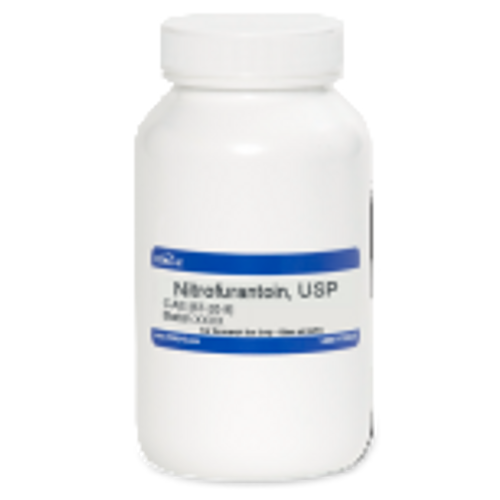Nitrofurantoin macrocrystals (syn: Macrobid) is formulated with Nitrofurantoin Monohydrate USP, an antibacterial compound used for the bacteria causing urinary tract and bladder infections. It was discovered in the 1940s. This synthetic product is created from furan and an added nitro group and a side change containing hydantoin. It has a slower rate of dissolution due to the macrocrystalline form.
We also offer:
- Nitrofurantoin Sodium (N061)
| Mechanism of Action | Nitrofurantoin has a unique mode of action in that it does not require growth or active metabolism to exert its effect. Upon entering a susceptible cell, Nitrofurantoin is activated by bacterial enzymes (nitrofuran reductase) and targets ribosomes and nucleic acids which inhibit bacterial growth and leads to death of the bacterial cells. Resistance to Nitrofurantoin may be chromosomal or plasmid-mediated. |
| Spectrum | Nitrofurantoin is a broad-spectrum antibiotic frequently used to treat bacterial infections of the urinary tract. Nitrofurantoin has been found to be effective against certain β-lactam resistant strains of VRE or vancomycin resistant Enterococcus; a glycopeptide antibiotic resistant "superbug." Nitrofurantoin is also used against Enterococci, Staphylococci, Streptococci, Corneybacteria, and E. coli. Most strains of Proteus spp. and Pseudomonas aeurginosa are resistant to Nitrofurantoin. |
| Microbiology Applications |
Nitrofurantoin is commonly used in clinical in vitro microbiological antimicrobial susceptibility tests (panels, discs, and MIC strips) against Gram-positive and Gram-negative microbial isolates. Medical microbiologists use AST results to recommend antibiotic treatment options. Representative MIC values include: E. coli 32 µg/mL - 64 µg/mL For a representative list of Nitrofurantoin MIC values, click here. Nitrofurantoin can be used against Lysteria monocytogenes-persisters in vitro, and was effective against both growing and dormant cells (Knudsen et al, 2013). |
| Eukaryotic Cell Culture Applications | Nitrofuranton is toxic to human WI-38 fibroblasts in culture and antioxidants can mitigate effect. On a molecular basis, glutathione peroxidase was the most efficient at protection (Michiels and Remacle, 1988). Nitrofurantoin can alter the morphology, viability, and phagocytic activity of bovine mammary polymorphonuclear leukocytes in vitro, when added at 1 mg/ml. |
| Cancer Research Applications | Nitrofurantoin was evaluated for cytotoxic activity against bladder cancer cells using three transitional cell carcinoma lines (HTB9 (grade 2); T24 (gr 3) and TccSup (gr. 4) at 0-2000 µg/ml using the MTT assay. Significant, dose-dependent cytotoxicity was seen at 7.8 µg/ml in all 3 cell lines (Kamat and Lamm, 2004). |
| Molecular Formula |
C8H8N4O5 |
| References |
Fitzpatrick PM and McOsker CM (1994) Nitrofurantoin: Mechanism of action and implications for resistance development in common uropathogens. J. Antimicrob. Chemother. 33(Suppl A):23-30 PMID 7928834 Kamat AM ad Lamm DL (2004) Antitumor activity of common antibiotics against superficial bladder cancer. Urol. 63(3):457-460 PMID 15028437 Knudsen GM, Ng Y and Gram L (2013) Survival of bactericidal antibiotic treatment by a persister subpopulation of Listeria monocytogenes. App. Environ. Microbiol. 79(23):7390-7397 PMID 24056460 Michiels C and Remacle J (1988) Quantitative study of natural antioxidant systems for cellular Nitrofurantoin toxicity. Biochim. Biophys. Acta 967(3):341-347 PMID 3196753 Nickerson SC, Paape MJ, Dulin AM (1985) Effect of antibiotics and vehicles on bovine mammary polymorphonuclear leukocyte morphologic features, viability, and phagocytic activity in vitro. Am J Vet Res. 46(11):2259-2265 PMID 4073636
|





